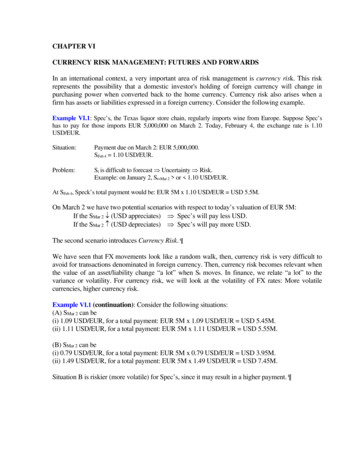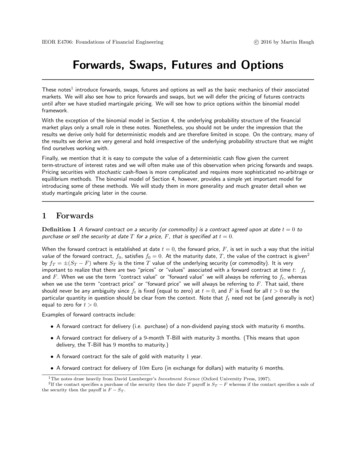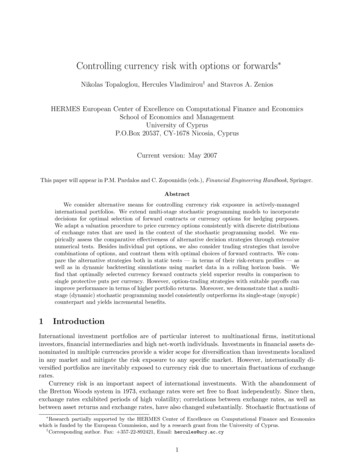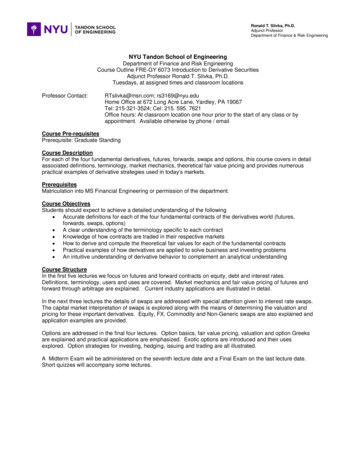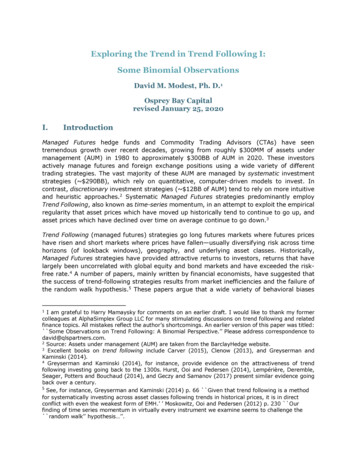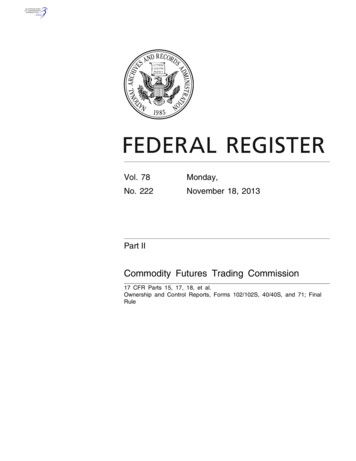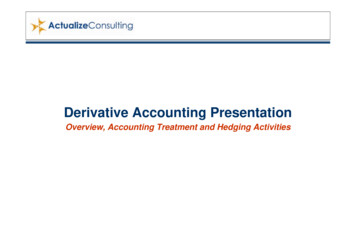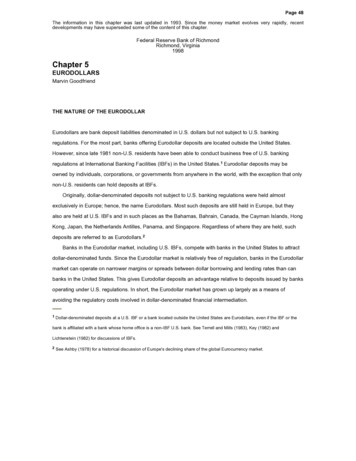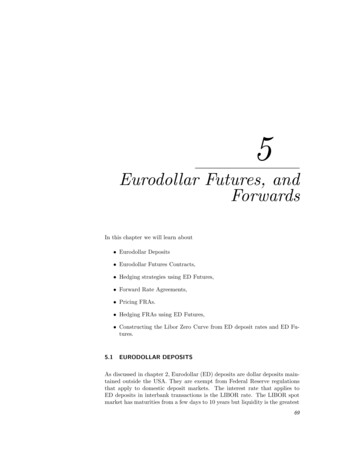
Transcription
5Eurodollar Futures, andForwardsIn this chapter we will learn about Eurodollar Deposits Eurodollar Futures Contracts, Hedging strategies using ED Futures, Forward Rate Agreements, Pricing FRAs. Hedging FRAs using ED Futures, Constructing the Libor Zero Curve from ED deposit rates and ED Futures.5.1EURODOLLAR DEPOSITSAs discussed in chapter 2, Eurodollar (ED) deposits are dollar deposits maintained outside the USA. They are exempt from Federal Reserve regulationsthat apply to domestic deposit markets. The interest rate that applies toED deposits in interbank transactions is the LIBOR rate. The LIBOR spotmarket has maturities from a few days to 10 years but liquidity is the greatest69
70CHAPTER 5: EURODOLLAR FUTURES AND FORWARDSTable 5.1 LIBOR spot 659mth1.2051yr1.337within one year. Table 5.1 shows LIBOR spot rates over a year as of January14th 2004.In the ED deposit market, deposits are traded between banks for ranges ofmaturities. If one million dollars is borrowed for 45 days at a LIBOR rate of5.25%, the interest isInterest 1m 0.052545 6562.50360The rate quoted assumes settlement will occur two days after the trade.Banks are willing to lend money to firms at the Libor rate provided theircredit is comparable to these strong banks. If their credit is weaker, then thelending bank may quote a rate as a spread over the Libor rate.5.2THE TED SPREADBanks that offer LIBOR deposits have the potential to default. The 3 monthLIBOR rate will therefore be set higher than the 3-month Treasury rate,with the spread between the two rates representing a premium for default.This Treasury-Eurodollar spread, called the TED spread fluctuates with time.When the economy is sound, spreads may be fairly small, but in times of crises,the spreads can be fairly large. The range in spreads can typically be between30 to 300 basis points.A firm that borrows funds over time will typically face interest rates morehighly correlated with LIBOR than with Treasury rates. Hence, rather thanuse futures contracts on Treasuries as a hedge, firms typically will look tohedge short term rates using Eurodollar (ED) futures.
CHAPTER 5: 90 DAY EURODOLLAR FUTURES5.37190 DAY EURODOLLAR FUTURESThe 90 day LIBOR rate is the yield derived on a 90 day ED deposit. EDfutures contracts that settle to a 90 day LIBOR rate are very actively traded.1The underlying security is a 1, 000, 000 90-day Libor deposit. The futurescontracts available mature in March, June, September and December of eachyear and extend out for about 10 years. In addition, the four nearest contractmonths also trade. The ED futures contract settles by cash on its expirationdate, which is the second London business day before the third Wednesdayof the maturity month. On the expiration date, the final settlement price isdetermined by the clearing house using the following procedure. At the closeof trading, a sample of 12 banks from a list of no more than 20 participatingbanks is randomly selected. These banks provide a quotation on 3 monthLIBOR deposit rates. The clearing house eliminates the lowest 2 and highesttwo quotes, and takes the arithmetic average of the remaining 12 quotes. Thisprocedure is repeated at a random time within 90 minutes. The average ofthese two prices determines the final LIBOR rate. The final settlement priceis established by subtracting this rate from 100. The average is rounded to thenearest 1/10000th of a percentage point, with decimal fractions ending in afive rounded up. For example, an average rate of 8.65625% would be roundedto 8.6563 and then subtracted from 100 to determine a final settlement priceof 91.3437.Let t0 be the expiration date of the futures contract, and let [t0 , t1] bethe LIBOR rate, expressed in annualized decimal form, at date t0 . Since thesettlement date is two days later, the rate [t0, t1] actually represents the ratefrom date t0 2 and t1 would be 90 days later. The final quoted futures indexprice isF U (t0) 100[1 [t0, t1]].Let F U (t) be the quoted index futures price at an earlier date t, t t0.The implied LIBOR interest rate is [100 F U (t)]%, or in decimal form:I t [t0, t1] 1 F U (t)100Thus, a futures index of 92 corresponds to an implied interest rate of 8%, orI t [t0 , t1] 0.08.The actual or effective dollar price of the contract differs from the indexbecause the yield is divided by four, so as to reflect a three month rate.Effective Price 1m (1 1 TheI t [t0 , t1])4futures contract traded on the CME is one of the most actively traded futures contractsin the world.
72CHAPTER 5: EURODOLLAR FUTURES AND FORWARDSExampleA trader buys a Eurodollar futures price at 92.0 and sells it the same day at92.08. The change of 8 basis points causes a price change of 200. Specifically,the profit to the long is given by:0.07920.080) 1m (1 )440.0800 0.07921m ()41m 0.0002 200.1m (1 Thus each basis point change in the annualized implied LIBOR rate is worth 25.A long position in a ED futures contract is really just a short position onthe 90 day LIBOR interest rate. In the last example the implied LIBOR ratedecreased by 8 basis points, from 8.0% to 7.92%, leading to a profit on thelong position of 8 25 200. A trader who sells ED futures, profits if ratesincrease.ED futures contracts that trade on SIMEX use the CME’s final settlementprice. These two exchanges designed a system that permits futures contractstraded on SIMEX to be completely interchangeable with contracts that tradeon the CME. The contract specifications on both exchanges are identical except for trading hours. However, a contract that trades on the floor of theCME can be transferred through the mutual offset system to SIMEX, andcancelled there. Similarly, a contract traded on the floor of SIMEX can betransferred to the CME. As a result, the trading hours of these contractsextends beyond the trading hours of either exchange.Table (5.2) shows the ED futures contracts that traded on January 15th2004. The cash settlement date for each contract is indicated as well as thegap, measured in days, between successive expiration dates. The settlementprice is indicated, and information from the previous day is supplied.Notice that actively traded ED Futures contracts exist with settlementdates that extend beyond 5 years. This is quite unusual. In most futuresmarkets, liquidity drops off very rapidly with maturity. The reason for highliquidity even in distant contracts relates to the use of these contracts ashedges for FRAs, Interest Rate Swaps, and other derivatives. This will bediscussed later.As an example, consider the June 2005 contract. The current implied Liborrate for this contract is 100 97.315 2.685%. A speculator who thinks thatthe 90 day spot Libor rate beginning from the June 2005 expiration date willbe much higher than this number might consider selling this futures contract.
CHAPTER 5: 90 DAY EURODOLLAR FUTURES73Table 5.2 Eurodollar Futures Information: January 15th 2004A plot of these successive 90 day implied futures rates against time, produces a curve that, in this case, rises from 1.125% to 6.66%. If we incorrectlyassumed that these futures rates were equal to forward rates, then we couldconstruct a LIBOR yield curve or a LIBOR discount bond curve.
74CHAPTER 5: EURODOLLAR FUTURES AND FORWARDS5.4CONSTRUCTING THE LIBOR DISCOUNT FUNCTIONIn Table (5.2), the first ED futures contract expires in 60 days. Assume1the 60-day spot LIBOR rate was 1.16%. Then, if (1 0.016 60/360) 0.99807dollars were placed in a ED deposit, after 60 days this would be worth 1.0.This discount factor is recorded in the second last column of the table. Byselling the March futures contract, the trader locks into a rate of 1.160% forthe period from March to June. The implied discount factor for that period1is therefore (1 0.016 91/360) 0.99708. The discount factor from January15th 2004 to 14th June 2004 is therefore the product of this number with theprevious discount factor. This value, 0.99515 is indicated in the second rowof the last column.In general, then, given the discount factor up to date tj is P (0, tj ), andgiven the implied ED futures rate for the next period [tj , tj 1], we computethe discount factor up to date tj 1 as follows:P (0, tj 1) P (0, tj )1(1 I [tj , tj 1] (tj 1 tj )/360)The resulting plot of these values against maturity constitute the LIBORdiscount function.The above analysis would be precise is the implied futures rates were forward rates. Recall that forward prices (rates) are NOT equal to futures prices(rates ) when interest rates are uncertain. The computation of forward ratesfrom these futures rates requires an adjustment downward.To see that a downward adjustment is necessary, recall that futures contracts are resettled daily. This resetlement process implies that there are dailycash flows into and out of the ED futures account. Consider a long positionin the futures contract. When rates drop, the futures price increases, producing cash inflows. Unfortunately, these profits are reinvested at the lower rate.Conversely, when rates rise, the long position will lose money, and these losseshave to be financed at higher rates. The negative impact of these reinvestments and borrowings must be compensated by a lower initial contract price,relative to the more advantageous forward contract. Lower ED futures pricesimply higher initial ED implied rates.The magnitude of the adjustment, referred to as the convexity adjustment,can be quantified and is the topic of a future chapter. The magnitude of theadjustment depends on the volatility of spot LIBOR and on the maturity ofthe futures contract. A very good approximation to the adjustment is givenby the formula:T2 TAdj 10, 000 σ2 ( ).28This adjustment is in basis points. The volatilty, σ is typically less than 0.01.The maturity, T, is measured in years from the current date to the expiration
CHAPTER 5: CONSTRUCTING THE LIBOR DISCOUNT FUNCTION75date of the futures. Using this value the downward adjustment to the impliedfutures rate for all our ED futures contracts are shown in Table (5.3).Table 5.3 Eurodollar Futures Information: January 15th 2004If the maturity is less than one year, the magnitude of the difference is usually less than a basis point. However, for longer dated contracts the convexity
76CHAPTER 5: EURODOLLAR FUTURES AND FORWARDSaffect can be fairly significant. For example, for a ten year contract, a ballpark adjustment is of the order of about 50 basis points. In comparing thetwo discount factors from the two tables, the impact of the adjustment canbe seen.We now illustrate how ED futures can be used to hedge against unanticipated interest rate movements.Hedging Against Interest Rate IncreasesConsider, the following problem. A bank provides a firm a three month loanof 1m starting in 3 months at the LIBOR rate at the start of the loan. Lett0 14 be the start date and t1 12 the final payment date. The interestexpense on this loan, due in 6 months is 1m [t04,t1 ] .Lets consider what happens if the firm sells 1 ED futures contract, with anexpiration date of 3 months. Ignoring the timing of cash flows due to markingto market, the profit from selling 1 ED futures contract at t0 is π(t0 ), whereπ(t0 ) 1m [ [t0, t1] I 0 [t0, t1] ].44(5.1)The net effective interest expense is therefore: 1m [t0, t1] [t0, t1] I 0 [t0, t1]I 0 [t0, t1] 1m [ 1m .4444Hence, by selling ED futures contracts, the firm exchanges an uncertain funding cost with a certain funding cost equal to the implied ED futures rate.Actually, the above analysis is only approximate, since we ignored thetiming of cash flows. First, the profit from the sale of the futures contract,given by equation (5.1), occurs at time t0 while the interest expense on theloan occurs at time t1. Second, we ignored the fact that with futures cashflows occur over the life of the contract, from date 0 to date t0 .To fix the first timing problem, assume rather than selling 1 futures contract, we sold Q contracts. Then, if we assume that the profit (negative, ifa loss) is invested in the ED market over the period [t0, t1], at date t1 it willhave grown to:π(t1 ) Q(1 [t0 , t1] [t0, t1] I 0 [t0, t1]) 1m [ ].444The net interest rate expense of the loan with hedging consists of the actualinterest, less the profit from selling the futures, and is given by C(t1 ), whereC(t1) 1m [t0 , t1] [t0 , t1] [t0, t1] I 0 [t0, t1] 1m Q(1 ) [ ]4444
CHAPTER 5: CONSTRUCTING THE LIBOR DISCOUNT FUNCTION77Now, at date 0, if we knew the future LIBOR rate, (t0 , t1), then by choosingQ (1 (t01,t1)/4) , the net interest expense with hedging would simplify to:I 0 [t0, t1].4Unfortunately, at date 0, we do not know (t0 , t1), so we cannot compute itexactly, but we may be able to estimate it well by the implied futures rateI 0 (t0 , t1). Then Q (1 I 0 (t10 ,t1)/4) . Other than the issue of estimating Q,we have resolved the first part of the timing mismatch.C(t1 ) 1m The second mismatch comes from the fact that we have really assumedthe contract was a forward contract rather than a futures contract. Recallthat futures contracts provide daily cash flows, over the period [0, t0], whereasforwards only provide this cash flow at the delivery date. The payoff from oneforward contract with settlement date t0 held over a day can be replicatedby a trading strategy involving trading P (0, t0) otherwise identical futurescontracts.To see this, assume at date 0, a forward contract is sold. Assume further that P (0, t0) futures were purchased. The next day the P (0, t0) futuresposition is liquidated for a profit equal to:P (0, t0) ( Change in Effective Futures Price).Now consider the change in value of a single forward contract held over oneday. Since the change in the forward price is only obtained at the deliverydate, the value associated with the change in forward
CHAPTER 5: 90 DAY EURODOLLAR FUTURES 71 5.3 90 DAY EURODOLLAR FUTURES The 90 day LIBOR rate is the yield derived on a 90 day ED deposit. ED futures contracts that settle to a 90 day LIBOR rate are very actively traded.1 The underlying security is a 1,000,00090-day Libor deposit. The futures contracts available mature in March, June, September and December of each year and
